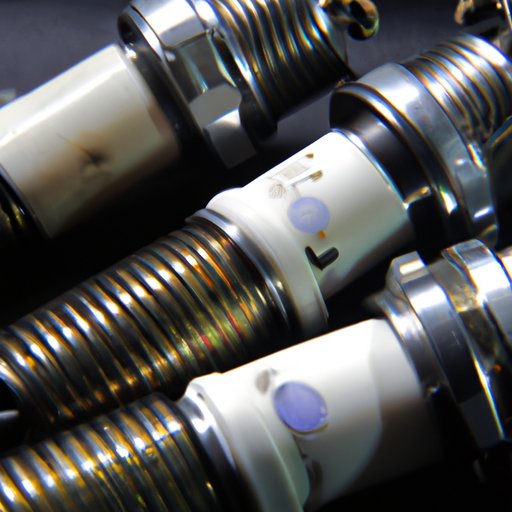
Introduction
Are you a car owner looking to improve the performance of your engine? Achieving the perfect air gap for your spark plugs is a crucial step in maximizing your engine’s potential. In this comprehensive guide, we will break down everything you need to know about spark plug gapping, why it is important, and how to do it yourself. Whether you’re a beginner or an experienced mechanic, this guide will provide valuable insights to help you improve your engine’s performance and fuel efficiency.
Spark Plug Gapping 101: A Comprehensive Guide for Beginners
Before we dive into the nitty-gritty of gapping spark plugs, let’s define what it is and why it’s important. Essentially, spark plug gapping refers to the precise measurement of the space between the center and ground electrodes of the spark plug. This space is also known as the “air gap.” The air gap is crucial because it determines the voltage required to create an arc for ignition.
To gap a spark plug, you’ll need a few basic tools, including a spark plug gapping tool, a feeler gauge, and a flathead screwdriver. A spark plug gapping tool is specially designed to help you measure and adjust the air gap. A feeler gauge is used to ensure that the gap is within the manufacturer’s specifications, and a flathead screwdriver is used to adjust the gap.
Achieving the Perfect Air Gap: Step-by-Step Instructions for Gapping Spark Plugs
Now that you know what spark plug gapping is and what tools you’ll need, let’s dive into the step-by-step process for gapping your spark plugs:
1. Consult your owner’s manual to determine the correct gap specification for your engine.
2. Remove the spark plugs from your engine, one at a time, using a spark plug socket.
3. Inspect the electrode for any damage, wear, or fouling. If the electrode is damaged or worn, replace the spark plug.
4. Using a spark plug gapping tool, measure the gap between the center and ground electrodes.
5. Check the gap measurement using a feeler gauge to ensure that it falls within the manufacturer’s specifications.
6. Adjust the gap using a flathead screwdriver, carefully bending the ground electrode until it reaches the desired measurement.
7. Reinstall the spark plug into the engine and tighten it to the manufacturer’s specifications.
8. Repeat the process for each spark plug.
It’s important to note that every engine is different, so it’s crucial to consult your owner’s manual for the correct gap specification. Additionally, be sure to use caution when adjusting the gap to avoid damaging the spark plug.
Maximizing Engine Performance: The Importance and How-To of Gapping Your Spark Plugs
Now that you know how to gap your spark plugs, let’s discuss why it’s important for maximizing engine performance. When the air gap is too narrow, the voltage required to create the ignition arc is too high, which can result in engine misfires, rough idling, and decreased fuel efficiency. On the other hand, if the gap is too wide, the voltage required to create the arc is too low, which can cause weak combustion and decreased engine performance.
To determine the right spark plug gap for your engine, consult your owner’s manual, or visit your local auto parts store. Many stores have a spark plug gap tool that can help you find the correct measurement for your engine.
DIY Auto Maintenance: Everything You Need to Know About Gapping Spark Plugs
Not only is gapping your spark plugs crucial for engine performance, but it’s also an essential part of DIY auto maintenance. By learning how to gap your spark plugs, you can save money on costly automotive repairs and keep your engine running smoothly.
One common problem that arises from incorrect spark plug gaps is fouling. Fouling occurs when the air gap is too narrow, causing a buildup of carbon deposits on the electrode. This buildup can lead to misfires, reduced engine performance, and even engine damage. By keeping your spark plug gap within the manufacturer’s specifications, you can avoid fouling and ensure that your engine is running at its best.
Expert Tips and Tricks for Precisely Gapping Your Spark Plugs and Boosting Fuel Efficiency
For those looking to take their spark plug gapping skills to the next level, there are a few expert tips and tricks to keep in mind:
1. Use a quality spark plug gapping tool to ensure accuracy.
2. Use a digital or dial gauge to measure the gap for even greater precision.
3. Consider upgrading to iridium or platinum spark plugs, which have a longer lifespan and require less frequent gapping.
4. Experiment with slightly wider or narrower gaps to find the optimal setting for your engine.
By following these tips, you can fine-tune your spark plug gap and improve your engine’s performance and fuel efficiency.
Conclusion
In conclusion, gapping your spark plugs is a small but crucial step in maintaining your engine’s performance and fuel efficiency. By following the step-by-step instructions outlined in this guide, you can gap your spark plugs with confidence and avoid common mistakes. Remember to consult your owner’s manual for the correct gap specification, and use caution when adjusting the gap to avoid damaging the spark plug. With these tips and tricks in mind, you can take your spark plug gapping skills to the next level and keep your engine running smoothly for years to come.




